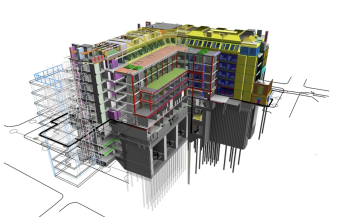Zigurat Global Institute of Technology
Blog / BIM & Construction Management
The implementation of BIM in India
Categories

Challenges ahead for the implementation of BIM in India
As many already know, Building Information Modeling, requires an initial investment of money and time but in the long run leads to increased productivity and profitability.
This is why some countries, including India, find the adoption of BIM especially challenging. This article aims to give a brief introduction to BIM in India, however, this will be discussed in more detail in the India BIM Summit that ZIGURAT will host in August.
According to Mr. Amarnath CB, founder of the India BIM Association, “We have about 30-40K people who are using BIM for projects, but most of the people providing these services are for the global markets. There are a very few who are providing the services for Indian projects." This is largely because studios are unable to explain and convince their clients of the benefits of BIM.
Furthermore, providing information about BIM implementation in various stages of projects is crucial. In India, many of the benefits provided by BIM are centered in the design process and rarely flow into the construction process. The India BIM Association (IBIMA) submitted a questionnaire to various industry and academic professionals. Thanks to this, it was possible to identify roadblocks for the implementation of BIM in India. Below are the key roadblocks:
BIM in India: Key Roadblocks
Those that use BIM in the design process have trouble implementing BIM during construction and FM. This contradiction together with a lack of awareness severely restricts the adoption of BIM in India.
Ignorance is not bliss
The advantages of BIM are slowly being recognized in India. However, the lack of a trained workforce in BIM makes adoption more complicated. This, according to Amarnath, is due to a poor education in BIM at the university level. BIM is a necessary tool for collaboration and everyone should be fully aware of the benefits that collaboration provides in terms of cost, effectiveness and efficiency. This awareness can only be achieved through education and therefore is extremely important to educate in BIM in Indian universities in order to facilitate adoption.
Work on Pricing
Companies that provide BIM services usually have higher rates, and lack of awareness of its benefits, leads to negative categorization. BIM becomes something expensive and many don’t understand exactly why or the advantages it provides. Although the cost of implementation is high, the benefits you obtain outweigh the initial investment. Consequently, people are beginning to realize these benefits.
Stronger policies required
In order for BIM adoption to take off, stronger policies are required. In contrast, policymakers are not fully aware of BIM or how to obtain the maximum benefit from it. Amarnath adds, “If we consider the national building code there is a rule that BIM must be used in construction, but it is not clear. We need to have guidelines in India to have clear-cut details about what kind of BIM needs to be delivered and the client can expect out of the project.”
BIM is a philosophy, not a software but a way of working. Large and small consultancies must implement this way of working to improve collaboration and ultimately efficiency.





